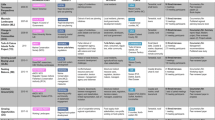Abstract
Effective public participation requires methods of policy analysis that can accommodate the discourse of the participants' opinions, preferences and values. This requires analytic methods that retain and convey the social and cultural contexts of the discourse of culturally diverse communities. Narrative policy analysis can incorporate cultural and social diversity within the process of analysing and presenting public preferences. Labov's evaluation model is used as a basis for describing how narrative analysis can be used to identify and present public preferences within a participation process. The value of this approach is demonstrated with reference to a participation process conducted on environmental quality.
Similar content being viewed by others
References
Boje, D. M. (1991). ‘The storytelling organisation: A study of story performance in an office supply firm,’ Administrative Science Quarterly 36: 106–126.
Bridgman, T. and D. Barry (2002). ‘Regulation is evil: An application of narrative policy analysis,’ Policy Sciences 35: 141–161.
Bruner, J. (1991). ‘The narrative construction of reality,’ Critical Inquiry 18: 1–21.
Cortazzi, M. (1991). Primary Teaching, How It Is – A Narrative Account. London: David Fulton.
Cortazzi, M. (1993). Narrative Analysis. London: Falmer Press.
Cvetkovich, G. and T. C. Earle (1992). ‘Environmental hazards and the public,’ Journal of Social Issues48: 1–20.
Darokin, D. J. and J. Schulkin (1994). ‘Environmental justice: co-evolution of environmental concerns and social justice,’ The Environmentalist14: 121–129.
deLeon, P. (1994). ‘Reinventing the policy sciences – 3 steps back to the future,’ Policy Sciences 27: 77–95.
Environment Protection Authority, New South Wales (1994). Benchmark Study on Environmental Knowledge, Attitudes, Skills and Behaviour in New South Wales. Sydney: Environment Protection Authority.
Environment Protection Authority, New South Wales (1997a). State of Environment Report. http://www.epa.nsw.gov.au/soe/97/ch1/12_1.htm
Environment Protection Authority, New South Wales (1997b). State of Environment Report. http://www.epa.nsw.gov.au/soe/97/ch1/12_4.htm
Environment Protection Authority, New South Wales (2002). Port Kembla Copper Fined for Pollution. http://www.epa.nsw.gov.au/media/0801/PKCair.htm
Falk, J., C. Fox, G. Hampton and K. Parker (1994). Review of Greenhouse Information Material. Canberra: Commonwealth Department of Sports, Environment and Tourism.
Falk, J., G. Hampton and K. Parker (1993). Illawarra Community Environmental Survey. Sydney: NSW Environment Protection Authority.
Garvin, T., and J. Eyles (1997). ‘The sun safety metanarrative: Translating science into public health discourse,’. Policy Sciences 30: 47–70.
Hampton, G. R. (1999). ‘Environmental equity and public participation,’ Policy Sciences32: 163–174.
Hampton, G. R. and A. Hodgkinson (1996). Regional Environmental Employment Strategy. Illawarra Region of Councils.
Institute for Participatory Planning. (1981). Citizen Participation Handbook for Public Officials and Others Serving the Public. Laramie, WY: Author.
International Association for Public Participation (1997). ‘Core values for the practice of public participation,’ The Practitioner April, 10.
Jordan, M. P. (1984). Rhetoric of Everyday English Texts. London: George Allen and Unwin.
Kaplan, T. J. (1986). ‘Narrative structure of policy analysis,’ Journal of Policy Analysis and Management 5: 761–788.
Krueger, R. A. (1994). Focus Groups: A Practical Guide for Applied Research. CA: Sage Publications.
Labov, W. (1972). ‘The transformation of experience in narrative syntax,’ in W. Labov, ed., Language in the Inner City. Philadelphia, PA: University of Pennsylvania, pp. 352–396.
LIST (1997). Illawarra Leukaemia Cluster Investigation Report, Prepared by the Leukaemia Investigation Steering Committee, for the Illawarra Area Health Service and the NSW Health Department. Illawarra Public Health Unit, Wollongong.
Mancuso, J. C. (1986). ‘The acquisition and use of narrative grammar structure,’ in T. R. Sarbin, ed., Narrative Psychology: The Storied Nature of Human Conduct. New York: Praeger, pp. 91–110.
Mishler, E. G. (1995). ‘Models of narrative analysis: A typology,’ Journal of Narrative and Life History 5: 87–123.
Pelletier, D., V. Kraak, C. McCullum, U. Uusitalo, and R. Rich. (1999). ‘The shaping of collective values through deliberative democracy: An empirical study from New York's North Country,’ Policy Sciences32: 103–131.
Polanyi, L. (1985). ‘Conversational story telling,’ in T. A. VanDijk ed., Handbook of Discourse Analysis. London: Academic, pp. 183–201.
Port Kembla Copper (2002). Newsletter August, 2002. http://www.pkc.com.au/newsletters.htm
Potter, J. and M. Wetherell. (1987). Discourse and Social Psychology. London: Sage Publications.
Roe, E. M. (1989). ‘Narrative analysis for the policy analyst: A case study of the 1980–1982 medfly controversy in California,’ Journal of Policy Analysis and Management8: 251–273.
Roe, E. M. (1994). Narrative Policy Analysis: Theory and Practice. Durham: Duke University Press.
Sampson, E. E. (1993). ‘Identity politics: Challenges to psychology's understanding,’ American Psychologist48: 1219–1230.
Schütz, A. and T. Luckmann (1974). The Structures of the Life World. (translated by R. Zaner and H.T. Engelhardt). Heinemann: London.
Stewart, D. W. and P. Shamdasini (1990). Focus Groups: Theory and Practice. Newbury Pk: Sage.
Ting-Toomey, S. and A. Kurogi (1998). ‘Facework: Competence in intercultural conflict: An updated face-negotiation theory,’ International Journal of Intercultural Relations 22: 187–225.
Turner, V. (1980). ‘Social dramas and stories about them,’ Critical Inquiry7: 141–168.
Viney, L. L. and L. Bousfield (1991). ‘Narrative analysis: A method of psychosocial research for AIDS-affected people,’ Social Science and Medicine32: 757–765.
Wollongong City Council (1995). Wollongong Profile: A Database for Community Planning. Wollongong: Wollongong City Council.
Workers Inquiry into Wollongong Leukaemia and Cancer Crisis (1997). Cancer and Industrial Pollution : The Findings of the Workers Inquiry into Wollongong Leukaemia and Cancer Crisis, September 9, 1997.Bankstown, N.S.W.: Labour Press.
Author information
Authors and Affiliations
Corresponding author
Rights and permissions
About this article
Cite this article
Hampton, G. Enhancing public participation through narrative analysis. Policy Sci 37, 261–276 (2004). https://doi.org/10.1007/s11077-005-1763-1
Published:
Issue Date:
DOI: https://doi.org/10.1007/s11077-005-1763-1




